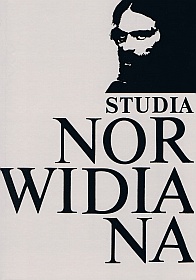Pseudo-Norwid, czyli co się komu podoba
Abstrakt
The present text critically discusses Wiesław Rzońca’s book Premodernizm Norwida – na tle symbolizmu literackiego drugiej połowy XIX wieku (Norwid’s Pre-modernism – Against the Background of the Literary Symbolism of the Second Half of the 19th Century) (Warszawa 2013). In the subsequent chapters the present polemics formulates the following charges against the book: 1). The division of Norwid’s work into “the mature period” and “the imma ture one” is unjustified and devoid of factual foundations; especially when in the allegedly “immature” period (until 1857) a lot of the poet’s undoubted masterpieces were written, also, the work after 1857 continued the earlier forms, ideas and motifs, and in this sense it was characterized by a relative – dynamic, flexible and open to changes – continuity. 2). One of Rzońca’s theses – an exceptionally doubtful one – puts Norwid’s allegedly “mature” works after 1857 outside Romanticism, which differs from the truth, both textual and historicalliterary, because Norwid till the end of his life drew on the Romantic tradition and traces of this practice can be discovered in most of his writings and poems, starting from his lectures On Juliusz Słowacki putting Byron (and not Baudelaire!) in the position of “poets’ Socrates”, and ending with Rzecz o wolności słowa (On the Freedom of Speech), perfectly well analyzed in the past by the late Zofia Stefanowska with respect to the Romantic influences retained in the poem, and with Milczenie (Silence), Ad leones!, Stygmat (Stigma) and Tajemnica lorda Singleworth (Lord Singleworth’s Secret). 3). Rzońca’s false diagnoses concerning Norwid’s relation towards Romantics and Romanticism result from a) accepting an extraordinarily narrow, static and basically false conception of Romanticism, reducing it personally to Mickiewicz and Byron, and ignoring the German, English, French, American, or even Polish Romanticism that was intellectually rich and creative (“not-well-enough-read” Krasiński or Słowacki plus the interesting Polish nationalist philosophy), and on which the whole 19th century, not only Norwid drew; b) the false (and grotesque) assumption that since Norwid drew on the European Romantics ample heritage, he necessarily deserves the strict etiquette of a “Romantic”, and the period of 1848-1857 should be absolutely associated with his “immaturity”. 4). Rzońca’s flagship theses about Norwid’s “pre-modernism” does not meet the conditions of sense, for anything you like may be associated with the concepts of “pre-modernism” or “modernism” that are used in the book. 5). The above charge also concerns the thesis about Norwid’s alleged “modernist symbolism”, as this kind of symbolism appeared only after the death of the poet. 6). Hence if it is possible to ascribe some significant historical-literary discovery to Rzońca, it is probably only the one creating Norwid as a posthumous symbolist. 7). Rzońca’s self-appraisal saying that his book presents “an attempt at a synthesis of Norwid’s mature work” (p. 9) should be assessed not only as an attempt – in an arrogant language, which Rzońca does not hesitate to use towards Norwid – decidedly “immature”, but as an unintentional parody of a “synthesis”. This is because Premodernism is a collection of subjective, not thought through impressions that say a lot about their author and his ambitions, but not much about the real, historical Norwid. Hence the title of the review: Pseudo-Norwid.
Copyright (c) 2014 Studia Norwidiana

Utwór dostępny jest na licencji Creative Commons Uznanie autorstwa – Użycie niekomercyjne – Bez utworów zależnych 4.0 Międzynarodowe.





